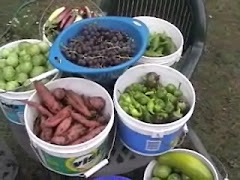
Mr. H, with a frenzied gleam in his eyes, declared "No matter how hard it is, no matter how long it takes, I will not be denied a radish! Oh, the root maggots might have gotten the best of me in years gone by, but no longer." This year I fought back, I grew the 'podding radish'." He exclaimed amid peals of deranged laughter.
I have tried and failed miserably to grow any sort of a decent radish for years now. I tried different varieties; big radishes, watermelon shaped radishes, black radishes, and white radishes. I even tried French radishes that I assumed must be so foreign to the northern reaches of Idaho the worms would not possibly be able to understand them... all to no avail. I tried growing them individually at the far corners of my garden. I put down ash. I even attempted to grow them through a plastic weed barrier. The maggots soundly defeated me on every front, burrowing into the fruits of my labor just before they could be harvested.
Then, last year I grew podding radishes. Oh yeah, I beat the dirty little buggers at their own game. No juicy little roots for them to tunnel through, no not one. The podding radish gives you all the delicious spicy flavor of a radish without the maggots. The loathsome monstrosities never could figure out how to crawl up the stock, which they would have to do in order to get at the pod.



You see, the podding radish, or rat-tailed radish, produces small inedible roots. The radish quickly bolts to seed and provides one with numerous plump edible pods that are a most delicious addition to salads and stir fries. The pods are best when harvested while still young and tender. As far as I know all radish seed pods can be eaten, but podding radishes were bred for their much larger more flavorful pods. No more maggot ridden radishes for me, no sir none at all.
Here is an informative article on podding radishes. http://www.kitchengardeners.org/rat-tailed_radish.html.






















11 comments:
How cleverly you beat the menace
When I lived on the Central Coast of California these marvelous plants covered acres of fields around my house, as wild flowers. I was the only person I knew of who ate them. How lovely to see them again!
That's one more for my list of things to try! Thanks for another interesting idea.
Have you tried the earthbound radish in clean soil in pots? I don't really have any other options, but a couple of pots with new seeds sown in the gaps as others are harvested have given us as much as we can eat, without any pest damage.
I'm just about to try some 'Weiner Runder Kohlschwarzer' winter radish too. They're not a salad radish, but seem like they might be useful to fill some gaps in winter: http://www.realseeds.co.uk/radish.html
Oh, I meant to add that 'rat-tailed' doesn't really do them justice - they look more like a flock of elegant birds to my eye.
Wow, I've never heard of podding radishes before. They're beautiful! Why isn't this a market crop? Especially if a lot of places have trouble with those maggots. Now I've got to try to grow some. Where did you find the seed?
Stefaneener,
Hupomone!
Translated in Greek it means patient endurance or perseverance... my favorite English word. Patient perseverance is a necessary part of a gardeners creed. Remaining under pressure without giving up. :)
By the way, I loved your last poem.
Hi Robin,
They do have lovely flowers. It's pretty interesting that they grow wild on the California coast. I would love to see them in such an environment.
Thanks for visiting,
Mike
Frugilegus,
That is a great idea, I should try that. Perhaps I will sterilize some soil this fall and plant a few in pots to see how they do. I'm surprised I never thought of that, thanks for the suggestion.
You are right, they don't look like the tail of a rat. A flock of birds...I like that.
Accidental Huswife,
It's so funny you should mention them not being a market crop as we were just discussing that today. They would be such a unique food item.
We got the seed from Bountiful Gardens and may be ordering more this next year. I was unable to save seed off them last year as they did not develop any, I will try again though.
cool. never eaten them. thanks for the tip.
I do grow the real mckoy however, using row cover - it works very well to prevent the fly from laying its eggs which then becomes the maggot (if you rotate your brassicas cause the little buggers overwinter in the soil).
Anne,
Thier great, and hold up in storage for a little while. They might be worth testing at the market.
Post a Comment